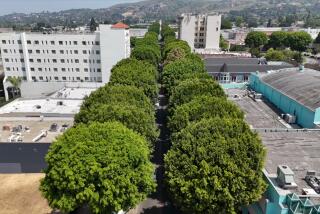Manhattan Beach Votes Down Tower
- Share via
In Manhattan Beach, a slice of yuppie heaven in the South Bay that’s populated with a plethora of lawyers, doctors and investment bankers, demand for cellular phone service is--and this is a bit of an understatement--quite high.
On the other hand, desire for a 125-foot-high cellular relay tower in a residential neighborhood is--and this is being most generous--quite low.
In a battle laced with irony, one that is being played out with increasing frequency in cities across the nation, the Manhattan Beach City Council on Tuesday night voted down a plan that would have plunked the 125-foot-high pole amid a bunch of homes.
The 5-0 vote capped months of protests from irate homeowners, many of them admitted cell phone fanatics. It also cast a spotlight on the intense passions--and fears--that such relay towers provoke. And it highlights the dilemma facing city planners as well as corporate executives--who pick their words carefully as they see consumers wanting to have it both ways.
The vote also served as a reminder of an enduring value: In a small town, neighborhood-style politicking still works. In a town where members of the City Council see constituents at the grocery store and the Little League field, there’s still a place for such old-fashioned strategies as petition drives and packing the crowd at planning commission meetings.
In the end, emotion--not logic or business sense--carried the day.
“I have seen these poles, and if the choice were given to me if I wanted to live next to one or not, I would say I wouldn’t want to either,” said Manhattan Beach Councilman Steve Napolitano.
But consumers want wireless service, and the opportunity for growth sizzles. In the Greater Los Angeles Area, only 16% of the population subscribes, according to Marty Zajic, a spokeswoman for Sprint PCS.
It’s not just that consumers are increasingly clamoring for service; it’s that they insist on dependable service, and in Manhattan Beach, that can be hard to come by. The town is hilly and dotted with “dark spots” in the airwaves.
That means calls frequently get dropped in the middle of conversations. Mindful that nothing so irks a cell phone customer, officials at Sprint PCS approached Manhattan Beach last year about installing a relay tower.
One of the smaller ironies that preceded Tuesday’s vote is that the tower wasn’t just going to be thrown up in someone’s backyard.
Instead, the pole would have gone up at the very site now occupied by the city’s hulking water tower--itself 125 feet high and hardly a visual delight. The big cream-colored tank is due to be replaced within two years by a system of pumps.
At first, city planners and Sprint executives thought they had hit upon a win-win proposition.
Currently atop the water tower are city police and fire antennas. When the water tower comes down, city officials have said, they will need a new, elevated place to hang those antennas.
Sprint offered to build a relay tower, dubbed a “monopole,” and to attach the city’s antennas.
The win-win proposition, however, turned out to be a neighborhood loser.
In April, homeowners met to plot a counter-strategy. The group then distributed more than 1,200 fliers around town and launched a petition drive. The petitions--about eight inches of paper--provide evidence of the emotions aroused.
In April, Richard Thompson, the city’s community development director, scheduled a meeting with residents. Afterward, he said homeowners were “extremely angry.”
In May, at the city’s planning commission meeting, homeowners packed the hearing--one of them vowing that a large number of residents would take the issue into consideration at election time.
The homeowners came with a laundry list of concerns:
They complained that the tower would diminish property values. They argued that it might pose a health or safety risk and might even fall down.
Officials responded to these concerns:
A dozen relay towers already operate in Manhattan Beach, some since 1990. There’s “no evidence” of declining property values, city staffers said.
As for health risks--many residents expressed fears of electromagnetic radiation--city officials said they were explicitly prohibited from taking that into consideration. As long as relay towers meet certain federal standards, a 1996 law says local officials may not deny a request to build such a tower on grounds that the “radio frequency emissions from the facilities will be harmful to the environment or health of residents.”
Finally, officials sought to assure homeowners that the monopole would not simply fall down. “Water towers don’t fall down. Flagpoles don’t fall down. Cell phone towers don’t fall down. That just doesn’t happen,” Thompson said this week.
Trying to salvage the project, a Sprint executive said perhaps the tower could be cut from 125 to 65 feet--if the city agreed not to drape it with antennas. He also suggested that the pole could be disguised to look like a tree--either pine or palm.
No go. The city planning commission voted to deny a permit for the pole. The vote was unanimous, 4-0. At the City Council meeting Tuesday night, the vote again was unanimous.
“As far as I’m concerned, it’s a dead issue,” Mayor Jack Cunningham said.
Not quite.
“There’s still a desire on our part to cover Manhattan Beach,” said Sprint spokeswoman Zajic. “We just have to figure out how to make that happen.”
More to Read
Sign up for Essential California
The most important California stories and recommendations in your inbox every morning.
You may occasionally receive promotional content from the Los Angeles Times.













